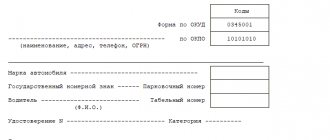Determining the procedure for using residential premises is, as a rule, the second stage of transforming common property into shared ownership. Files in .DOC: Form of agreement to determine the procedure for using residential premises Sample agreement to determine the procedure for using residential premises
Agreements in this part are rare, since determining the procedure for using housing is usually the result of an acute dispute between persons living in the same apartment or house. It is very difficult to resolve such a dispute peacefully, and therefore the use of housing is most often established through a court decision.
Property stages
The law defines the following types of property:
- personal;
- general (joint);
- fractional ideal;
- share real.
Moreover, all these types of property have the ability to “migrate” from one type to another. Let's give an example to visualize this “migration”:
- Someone Illarionov A.A. died without leaving a will. At the time of his death, he owned 1/2 of a three-room apartment, which he purchased together with his wife. His three children had the right to inherit the apartment.
- Each of the four received their certificate of acceptance of inheritance and became the owner of 1/3 of the apartment. The shares turned out to be ideal, that is, abstract, since they did not have boundaries, were not rooms, etc. Thus, Illarionov’s personal property turned into shared property with ideal shares.
- After receiving the inheritance, the sisters quarreled among themselves, and the eldest sister cut a lock into the kitchen door, preventing the other sisters from using the kitchen. After a series of scandals, the sisters decided to establish a procedure for use in order to gain the right to use each specific room and have access to the kitchen, bathroom and balcony. They went to court, which established the procedure for using the residential premises. So the ideal shares turned into real shares.
- Since the apartment was on the ground floor, the sisters decided to make a separate entrance to each of the rooms, that is, to isolate themselves. They received permission for redevelopment and extension, thus each receiving separate, separate housing. The changes made were registered in the BTI and the sisters each received a separate apartment number, that is, a separate address. Thus, real shares became personal property, and common shared property ceased to exist.
- If we assume that after the death of any of the sisters, her apartment will be inherited by her two heirs, then personal property will again turn into common property, repeating the cycle of property.
Such an example is not at all abstract, and judicial practice knows cases when co-owners reached 1/12 shares.
Contents of the agreement
Chapters 35 and 36 of the Civil Code of the Russian Federation determine the conditions and procedure for an agreement on the use of residential premises. And Article 423 of the Civil Code of the Russian Federation stipulates the remuneration and gratuitousness of contractual relations.
If you decide to conclude an agreement, you can use a ready-made sample.
But remember that it must contain basic information, without which the contract cannot be considered valid.
The agreement must contain the following sections:
- Parties to the contract.
- An object that serves as a living space.
- Free provision of housing.
- Responsibility, rights and obligations of the parties.
- Terms of termination.
- Place and date of conclusion.
- Signatures of the parties.
Parties to the transaction can only be individuals. It is necessary to indicate the full passport details and place of residence of each party to the transaction.
It is important that there are no errors in the information provided. If they do not correspond to the data from the passport, the document will not be considered legally valid.
The contract must contain a separate indication that the transaction is free of charge. If the owner expects the tenant to pay the rent, it is better to negotiate this separately. Otherwise, the contract cannot be considered gratuitous, since it will include the need for payment.
The responsibility of the parties, as a rule, states that the owner undertakes to provide housing for living, and the tenant undertakes to maintain it in proper condition. If the contract has terminated and the tenant continues to reside, the contract is considered renewed free of charge. But the owner should not be against this.
Thus, the agreement for the use of residential premises becomes a legal guarantee not only for the owner of the property, but also for the tenant. It establishes the basic rights and obligations of the parties, which does not create controversial situations. And if a dispute does arise, it can be resolved pre-trial and in court.
This is important to know: Common property in civil law
The video story will tell you why a contract for the use of residential premises should be concluded
Reasons for determining the order of use
As mentioned above, determining the order of use is always a consequence of a conflict. The causes of the conflict may be the following conditions:
- a co-owner occupies a premises in housing with an area larger than his share in the common property. For example, with the right to 1/3 in an apartment, the co-owner occupies a room equal to half the living space;
- one of the co-owners restricts the other co-owners’ right to use utility rooms (kitchen, balcony, toilet, pantry);
- the presence in the residential premises of one walk-through room, in which isolated living is difficult;
- the desire of one of the co-owners to move into a room with a larger area than his share, provided that the other co-owner does not live in the apartment at all;
- the presence of strained relations between co-owners, in which one party simply wants to get on the nerves of the other co-owners.
Since conflicts between co-owners can reach a high degree of intensity, a peaceful settlement of a dispute about the order of use between them is practically impossible. Therefore, most legal relations, one way or another connected with the transformation of ideal shares into real ones, are resolved through a claim to determine the procedure for using residential premises.
If the conflict is not clearly expressed or if during the trial the co-owners decided to resolve the dispute on their own, the law allows them to enter into an agreement to determine the procedure for use.
Procedure for using residential premises
According to the Civil Code of the Russian Federation, owners have the rights to own, use and dispose of their real estate equally.
The procedure for using residential premises implies providing each of the residents with the opportunity to choose a specific room or rooms based on the size of their shares in the apartment.
The established procedure for using residential premises is a situation in which the residents of the apartment have been living with each other peacefully for a long time and have agreed on the procedure for using the apartment orally.
Limits of use
The use of residential premises refers to established rules, according to which co-owners or tenants:
- occupy a certain place in the living room:
- use utility rooms;
- use passages to common areas.
With long-term joint ownership and use of residential premises, a so-called established order develops. To a certain extent, it is the established order of use that the courts are guided by when making decisions on establishing the order.
It should be clarified that determining the order of use does not at all mean allocating a separate room to each of the co-owners in conditions where there are more co-owners than the number of rooms in the residential premises. This means that claims for this category of disputes are extremely complex, and even more difficult to resolve the dispute through peaceful negotiations.
When making a decision, the court takes into account many factors, ranging from the number of co-owners actually living in the residential premises and ending with an expert’s opinion on the possibility of dividing the housing.
Features of using housing
A contract for the use of residential premises is possible only between individuals. It only applies to accommodation. If questions arise about additional expenses and payment of utility bills, they must be discussed separately.
And despite the fact that some financial costs may arise, such an agreement cannot be considered a lease agreement. This is due to the fact that it does not set rent.
According to current legislation, you cannot enter into a lease agreement that does not require payment. Any rental agreement involves payment for the use of someone else's property. In accordance with the civil code, an agreement for the use of premises is called a loan. But this term in this aspect has nothing to do with obtaining borrowed funds.
A contract for the use of residential premises is possible only between private individuals. The parties to the agreement are not the tenant with the landlord, but the borrower with the lender.
Ways to determine order
There are three possibilities to determine the order of use of residential premises:
- go to court with a corresponding claim;
- draw up an agreement on the procedure for using housing;
- draw up a settlement agreement during the legal proceedings.
Of course, it is necessary to go to court when a peaceful determination of order is impossible.
In order to provide the court with evidence of this impossibility, it is advisable for one of the co-owners to send a written proposal to the other co-owners to resolve the conflict by voluntarily determining the order of use. You may be able to include a copy of these written notices when filing your claim.
It is also possible to reach an agreement during the consideration of the case in court and enter into a settlement agreement. Such an agreement is approved by the court and subsequently becomes the equivalent of a writ of execution if any of the co-owners evades the terms of the settlement agreement.
Determining the procedure for using residential premises in court
Situations in which owners of common shared property exist peacefully with each other are the exception rather than the rule. Most often, people cannot agree on the procedure for using an apartment and turn to the courts to resolve the dispute.
Please note that legal disputes of this category are not uncommon, so you should know a certain procedure for resolving such conflicts.
The need to determine the procedure for using residential premises in court arises in cases where the owners fail to reach an agreement peacefully.
In addition, you can go to court if one of the owners wishes to allocate in kind his share in the property. The court has the right to refuse it if such allocation violates the rights and interests of other participants in the common shared property.
If he is denied satisfaction of the stated requirements, this is not an obstacle to re-applying to the court to determine the procedure for using the residential premises.
When making a decision, the court takes into account the following circumstances:
- the procedure for using property before disagreements arise between apartment owners;
- the need of each resident to use a certain part of the living space;
- the health status of the owners;
- the presence of minor children of each of the owners;
- the contribution of each resident to improving the condition of the living space;
- the number of rooms available in the disputed residential premises;
- the share of each co-owner in the disputed residential premises.
Owners of residential premises must prove each of the above circumstances independently. This can be done by providing documents, witness statements or an agreement on the use of residential premises.
Drawing up an agreement
An agreement can be drawn up on two grounds:
- as a written confirmation of an already established procedure for use;
- as a result of an agreement on a dispute.
The agreement is drawn up in simple written form, that is, it does not require notarization. However, this rule will not be an obstacle to contacting a notary if the co-owners so desire.
The text of the agreement must contain the following information:
- Full name of co-owners;
- description of the right of each of the co-owners to use the residential premises (share by inheritance, share in the common property of spouses, other ways of acquiring the right of shared ownership);
- characteristics and address of the residential premises, including information about the area, number of rooms, common areas;
- a statement of the terms of the agreement, namely the will of each of the co-owners to establish a general procedure for use;
- the actual terms of the agreement. For example, “the co-owners establish the following procedure for use. Ivanov I.I. enjoys a room of 16 m² and has unobstructed access to the bathroom, storage room and kitchen. Ivanov A.I. enjoys a room of 18 m² and has unobstructed access to the kitchen and bathroom. Ivanova M.I. uses a room of 14 m² and has unhindered access to the balcony, bathroom and kitchen”;
- signatures of all parties to the agreement and the date of its preparation.
Features of the agreement
The law allows you to formalize an agreement either orally or in writing. But only in the latter case can conflicts be avoided or resolved through legislation. Some owners do not enter into an agreement, especially if they are related. But over time, you may encounter a controversial situation that can only be resolved in court. Therefore, it is better to conclude the agreement in writing.
The contract must contain the following:
| Validity of the agreement | The owner can specify any period that gives the tenant the right to stay. If the term is not specified, the agreement is considered to be of unlimited duration. |
| Procedure for using housing | The main condition is the intended use of the premises. If this clause is violated, the owner has the opportunity to terminate the contract and obtain financial compensation through the court. This can happen in cases where the tenant uses the apartment as a warehouse or retail space. |
| Priority when concluding a contract | If the contract has expired, by agreement with the owner, you can renew the contract on the same terms. |
| Improving living conditions | If the tenant has improved the condition of the home, he may receive financial compensation when moving. If improvements cannot be separated, improvements are made with the consent of the owner. |
| Condition of the apartment | According to the standard terms of the contract, the tenant is obliged to return the apartment in its original condition. To avoid further disputes, you should draw up a transfer and acceptance certificate with a technical description of the living space and property. |
This is important to know: Regulations on the structural unit of the kindergarten
The document must contain essential conditions, without which the housing cannot be transferred for use.
In this case, the main condition is the availability of an apartment or house, which is transferred to the tenant. Therefore, the contract must describe in detail all information about the housing, such as area and location.
If an apartment is provided for use by several residents, the procedure for using common areas is determined. These are areas such as a kitchen, a bathroom and a common living room.
Important! The agreement for the use of residential premises does not need to be submitted to the registration authority or certified by a notary. This is due to the fact that the document is free of charge. The agreement comes into force after the signatures of both parties.
Settlement agreement in court
The claim process can be very lengthy and costly. Moreover, neither the plaintiff nor the defendant can be sure that the decision made by the court will satisfy them.
An option to avoid wasting time and money, as well as the possibility of obtaining an unfavorable solution, would be to conclude a settlement agreement between the parties to the process.
You can inform the court about the existence of a settlement agreement both in court and outside it, by filing a petition through the office.
The settlement agreement itself can be oral or written. The written agreement is attached to the materials of the civil case, and the oral agreement is entered by the secretary into the minutes of the court session.
It is still advisable to draw up a written agreement and relieve the secretary of the need to take notes on the text, every word of which may be important. Simultaneously with the agreement, a petition for approval of the settlement agreement is also submitted.
The consideration of the petition takes place at a court hearing. During the consideration, the judge establishes the voluntariness of his conclusion and the validity of its conditions, after which he retires to the deliberation room.
Based on the results of the review, the court either approves the agreement or refuses to approve it. In the first case, the proceedings are terminated, and in the second, they continue until a court decision is made. Rejection of a settlement agreement may occur if its terms violate the rights of other persons, in particular minors or incapacitated persons.
Contents of the settlement agreement
In general, the content of the settlement agreement corresponds to the content of the agreement drawn up in pre-trial procedure. The specifics of the settlement agreement will be the following:
- the name of the court that is considering the case;
- civil case number and name of the claim;
- information about the procedural status of the parties to the agreement (plaintiff and defendant);
- presentation to the court of a request to approve the settlement agreement and terminate the proceedings.
A settlement agreement approved by the court receives the status of a binding one, and if any of the parties evades the fulfillment of the obligations assumed under the agreement, it acquires the force of a court decision. This means that the agreement can be submitted to a bailiff for enforcement.








